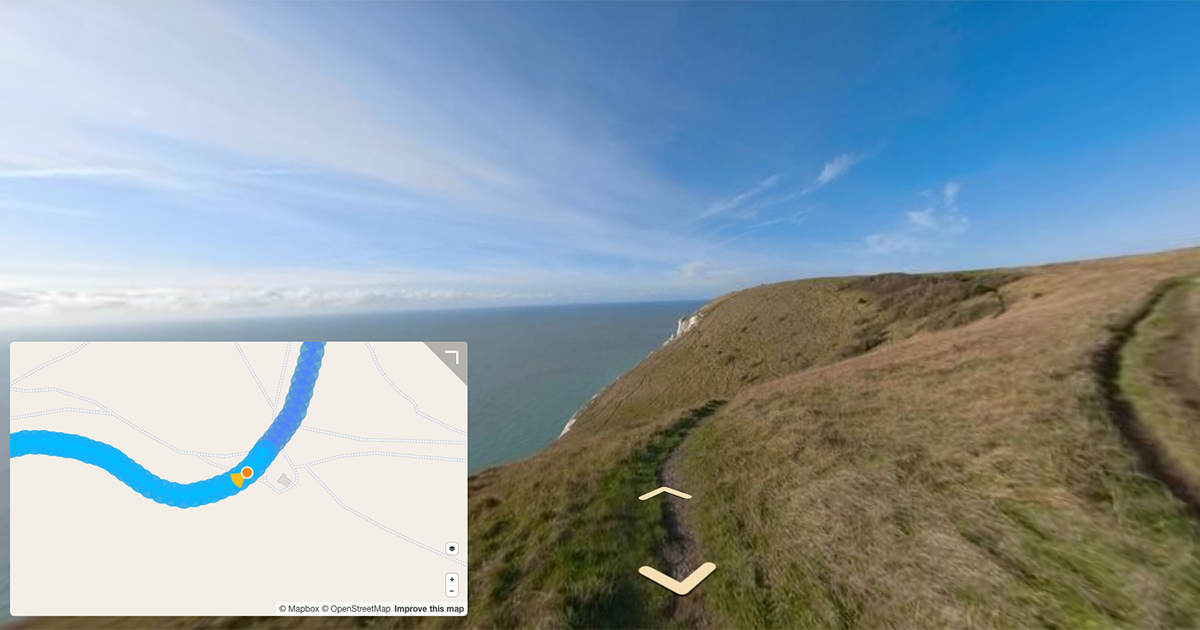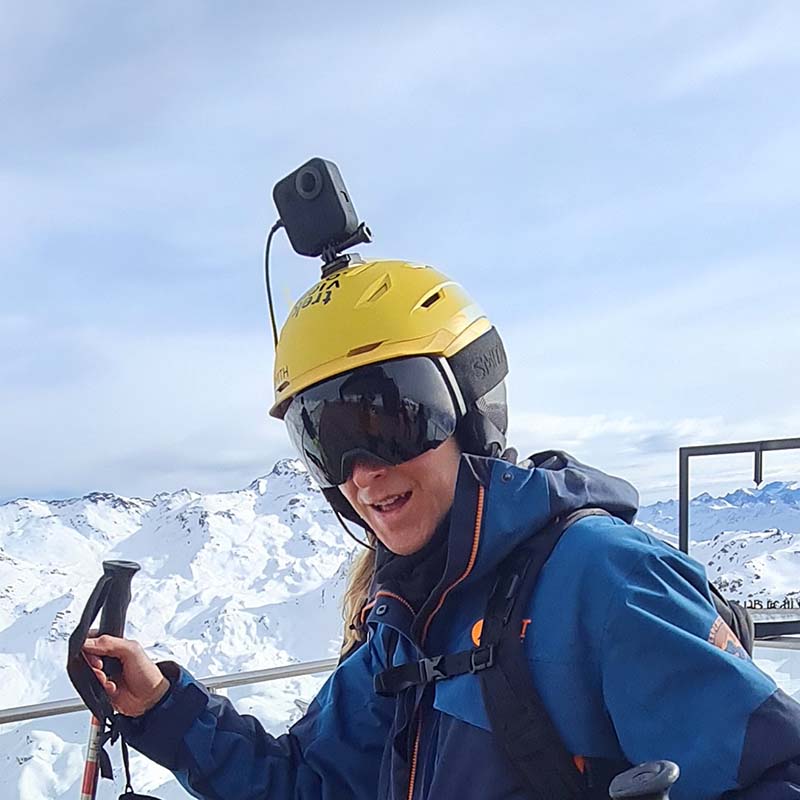In our continued effort to avoid reliance on GoPro software, I look at how ffmpeg can be used to process GoPro EAC projected videos (.360’s) to equirectangular projections.
You might have seen my previous series of posts; Reversing engineering GoPro MAX .360 videos (convert to equirectangular projection).
The outcome of this post was a proof-of-concept called MAX2Sphere.
Recently, I’ve seen a few ffmpeg builds for GoPro .360 conversions that do a similar thing.
Of course this meant I had to play with them… and here is what I found.
1. GoPro MAX .360 input
The GoPro MAX produces a single .360 file (GoPro’s EAC projection type) for 360 videos. I’ve talked about these in detail previously.
In short GoPro’s .360’s contain two video tracks which form a EAC custom cubemap projection. You can see the structure of .360’s using ffprobe:
Duration: 00:00:20.22, start: 0.000000, bitrate: 66599 kb/s
Stream #0:0[0x1](eng): Video: hevc (Main) (hvc1 / 0x31637668), yuvj420p(pc, bt709), 4096x1344 [SAR 1:1 DAR 64:21], 29985 kb/s, 29.97 fps, 29.97 tbr, 90k tbn (default)
Metadata:
creation_time : 2021-09-04T08:23:32.000000Z
handler_name : GoPro H.265
vendor_id : [0][0][0][0]
encoder : GoPro H.265 encoder
timecode : 08:23:02:08
Stream #0:1[0x2](eng): Audio: aac (LC) (mp4a / 0x6134706D), 48000 Hz, stereo, fltp, 188 kb/s (default)
Metadata:
creation_time : 2021-09-04T08:23:32.000000Z
handler_name : GoPro AAC
vendor_id : [0][0][0][0]
timecode : 08:23:02:08
Stream #0:2[0x3](eng): Data: none (tmcd / 0x64636D74), 0 kb/s (default)
Metadata:
creation_time : 2021-09-04T08:23:32.000000Z
handler_name : GoPro TCD
timecode : 08:23:02:08
Stream #0:3[0x4](eng): Data: bin_data (gpmd / 0x646D7067), 91 kb/s (default)
Metadata:
creation_time : 2021-09-04T08:23:32.000000Z
handler_name : GoPro MET
Stream #0:4[0x5](eng): Data: none (fdsc / 0x63736466), 20 kb/s (default)
Metadata:
creation_time : 2021-09-04T08:23:32.000000Z
handler_name : GoPro SOS
Stream #0:5[0x6](eng): Video: hevc (Main) (hvc1 / 0x31637668), yuvj420p(pc, bt709), 4096x1344 [SAR 1:1 DAR 64:21], 30109 kb/s, 29.97 fps, 29.97 tbr, 90k tbn (default)
Metadata:
creation_time : 2021-09-04T08:23:32.000000Z
handler_name : GoPro H.265
vendor_id : [0][0][0][0]
encoder : GoPro H.265 encoder
timecode : 08:23:02:08
Side data:
displaymatrix: rotation of nan degrees
Stream #0:6[0x7](eng): Audio: pcm_s32le (in32 / 0x32336E69), 48000 Hz, 4 channels, s32, 6144 kb/s (default)
Metadata:
creation_time : 2021-09-04T08:23:32.000000Z
handler_name : GoPro AMB
vendor_id : [0][0][0][0]
Unsupported codec with id 0 for input stream 2
Unsupported codec with id 98314 for input stream
2. Build and install ffmpeg
As hinted at the top of this post, the master ffmpeg software build does not contain the right filters to convert GoPro’s EAC format out of the box (at the time of writing). Therefore you first need to build a custom fork of ffmpeg which contains these filter.
First grab this custom fork of ffmpeg.
You should run this install in a virtual/separate environment, so as not to cause conflicts with your stable ffmpeg install.
git clone https://github.com/gmat/goproMax-ffmpeg-v5
cd goproMax-ffmpeg-v5
Now you need to install the ffmpeg dependencies, as detailed here (for Ubuntu).
Build ffmpeg using the makefile (this will take a long time);
$ sudo apt-get install -y ocl-icd-opencl-dev
$ ./configure --enable-opencl --enable-opengl --enable-sdl2 --enable-libx264 --enable-gpl --disable-x86asm
$ make
$ sudo make install
# test ffmpeg works
$ ffmpeg
3. Convert .360 to equirectangular mp4
I’ll use the following .360 file as an example:
Quickly grab it using gdown like so:
$ pip install gdown
# Use test 360 GS018421.360
$ gdown --id 1FT1oth6HHMFnzP_2jk8JpGPmlzjeBhIb
Now we can run the ffmpeg conversion on GS018421.360:
ffmpeg -hwaccel opencl -v verbose -filter_complex '[0:0]format=yuv420p,hwupload[a] , [0:5]format=yuv420p,hwupload[b], [a][b]gopromax_opencl, hwdownload,format=yuv420p' -i GS018421.360 -c:v libx264 -pix_fmt yuv420p -map_metadata 0 -map 0:a -map 0:3 GS018421-stitched.mp4
Let me break this down;
-hwaccel opencl
Many platforms offer access to dedicated hardware to perform a range of video-related tasks. In this case I am using OpenCL. OpenCL (Open Computing Language) is a low-level API for heterogeneous computing that runs on CUDA-powered GPUs.
A note on hardware acceleration
This command requires the use of hardware acceleration in ffmpeg, which you can read more about here.
If you are using a general purpose laptop you might run into issues, like the one shown below;
[AVHWDeviceContext @ 0x55714eaff000] No matching devices found.
Device creation failed: -19.
Failed to set value 'opencl:0.1' for option 'init_hw_device': No such device
Error parsing global options: No such device
This is due to hardware issues, specifically the lack or mis-configuration of a GPU or vGPU (and usually occurs on laptops, which have no GPU). Due to the variety of hardware available, I can only point you to Google to debug (or to use a cloud server with a CPU like AWS’s NVIDIA GPU backed EC2 machines).
End note
-v verbose
Sets the logging level to verbose (as detailed as possible). This is useful because we are using a non-supported fork of ffmpeg and thus can help debug any issues that occur.
-filter_complex '[0:0]format=yuv420p,hwupload[a] , [0:5]format=yuv420p,hwupload[b], [a][b]gopromax_opencl, hwdownload,format=yuv420p'
Here the command calls the filter to convert the input to equirectangular.
Essentially it takes the two video tracks 0:0 and 0:5 as [a] and [b] respectively from the .360 file, and passes them to the gopromax_opencl filter, the logic (code) of which can be viewed here.
We know the video streams in this video are 0:0 and 0:5 for this video using ffprobe, but beware, if the video was shot in Time Warp mode the video streams are in 0:0 and 0:4 – be sure to check with your video. This is because Time Warp videos do not contain an audio track (hence one less track).
-i GS018421.360
Where GS018421.360 is the .360 input video (EAC projection) you want to convert to an .mp4 as an equirectangular projection.
-c:v libx264 -pix_fmt yuv420p -map_metadata 0 -map 0:a -map 0:3 GS018421-stitched.mp4
And finally, we define the output settings, including encoding, mapping metadata and telemetry streams to create a final file, GS018421-stitched.mp4.
We know the telemetry stream is 0:3 for this video using ffprobe, but beware, if the video was shot in Time Warp mode the telemetry stream is 0:2 – be sure to check with your video. Again, this is because Time Warp videos do not contain an audio track.
5. The mp4 output
This command gives a final output that looks like this:
Note: no equirectangular metadata has been added to the video (hence no 360 controls). See how to do this here.
Both video and audio look and sound good, it is equirectangular, but what about the streams?
Duration: 00:00:20.48, start: 0.000000, bitrate: 89967 kb/s
Stream #0:0[0x1](und): Video: h264 (High) (avc1 / 0x31637661), yuv420p(tv, bt709, progressive), 5376x2688 [SAR 1:1 DAR 2:1], 90627 kb/s, 29.97 fps, 29.97 tbr, 30k tbn (default)
Metadata:
creation_time : 2021-09-04T08:23:32.000000Z
handler_name : VideoHandler
vendor_id : [0][0][0][0]
Stream #0:1[0x2](eng): Audio: aac (LC) (mp4a / 0x6134706D), 48000 Hz, stereo, fltp, 125 kb/s (default)
Metadata:
creation_time : 2021-09-04T08:23:32.000000Z
handler_name : GoPro AAC
vendor_id : [0][0][0][0]
Stream #0:2[0x3](eng): Audio: aac (LC) (mp4a / 0x6134706D), 48000 Hz, 4.0, fltp, 263 kb/s (default)
Metadata:
creation_time : 2021-09-04T08:23:32.000000Z
handler_name : GoPro AMB
vendor_id : [0][0][0][0]
Stream #0:3[0x4](eng): Data: bin_data (gpmd / 0x646D7067), 91 kb/s (default)
Metadata:
creation_time : 2021-09-04T08:23:32.000000Z
handler_name : GoPro MET
Unsupported codec with id 98314 for input stream 3
Here we can see the telemetry has also copied successfully into stream 0:3.
You will also see that a second audio track (GoPro specific – GoPro AMB track in stream 0:2) has also copied successfully.
The one thing I don’t quite understand is why the output .mp4 has a duration of 00:00:20.48, yet the input .360 has a duration of 00:00:20.22 – a 0.26 second difference. If anyone reading this has any ideas as to why this occurs, please do drop me an email.
6. Pros and cons of MAX2Sphere vs ffmpeg
If you have tried using the above instructions on a longer video (more than 2 minutes), it is very likely it took a long time to process.
If you need to process an entire video, ffmpeg is the fastest and easiest approach (because it does not require separate frame extraction and stitching). You will just have to deal with the processing time (or buy bigger hardware).
However, if you only need a limited number of frames, for example 1 or 2 frames per second to create a virtual tour, then MAX2Sphere is the way to go – it will be much faster.
We're building a Street View alternative for explorers
If you'd like to be the first to receive monthly updates about the project, subscribe to our newsletter...


